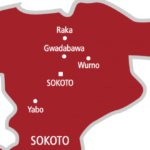In Nigeria, ethnic groups such as the Yoruba, Hausa, Kanuri, Nupe, Jarawa in Plateau and Igala were known to have some of the most invasive scars.
Are tribal marks going into extinction?
The marks range from three horizontal marks on each cheek to identify the Oyo people; to vertical marks, one on each cheek for Ondo people all of Yoruba extraction.
The Jarawa people are known to draw many tiny incisions from the head to the chin, while the Nupe have tiny cat-like whiskers beside the lips.
Marks are also given on other parts of the body apart from the face.
Apart from tribal identification, the marks are also used to initiate people into age grades and cults, among others.
Mr Stephen Eruada, the Public Relations Officer, Arts and Crafts Village, Abuja, says that tribal marks are given for various reasons.
“In those days it was survival of the fittest and conquest of the strongest, so, in battle what you use in identification was the mark.
“Some of these tribal marks have something to do with the deities, like those who worship the Orisa or Ogun,’’ he says.
Yidiat Olatunji, a make-up artist, says her father gave her tribal marks because he wanted to continue with the tradition, adding that many people woo or “toast’’ her because of her tribal marks.
“You might like to hear that a white man once approached me for a relationship here in Ibadan some years back.
“I asked him what attracted him to me and he referred to my marks. A lot of people still woo me despite my marks,’’ Olatunji says.
Mr Akeem Olagoke, who has the `jamgbadi’ tribal marks, says it has psychological effects on him.
“When I was in the university, I found it very difficult to ask a lady out because I already had a low self-esteem due to the marks.
“I cannot just imagine anyone going through the same thing I went through.
“I was often referred to as Akeem okoola, meaning Akeem the mark bearer and that was embarrassing.’’
However, the tradition is gradually dying. A state like Osun has even banned giving tribal marks. The prohibition is contained in the state’s Child Rights Law, which imposes N5, 000 fines or one month imprisonment or both for violation.
The law states inter alia: “No person shall tattoo or make a skin mark or cause any tattoo or skin mark to be made on a child.’’
Giving reasons for its seeming extinction, Eruada says it does not hide the identity of the bearer.
“People sometimes want to hide their identity, but one with tribal marks cannot do so,’’ he says.
A school teacher, Esther Yakubu, says that it should be banned, as it has no advantage.
She says that tribal marks in a country like Nigeria is very disadvantageous, adding that from the marks, your ethnic group is known.
“If a parent fees that he had lost something in life like a job opportunity, relationship with people due to the marks on his face, he wouldn’t want to give such marks to his child to avoid the same emotional setbacks he experienced.’’
However, some people still want the archaic practice to continue, describing it as a heritage that ought to be preserved.
Mr Kazeem Oguntade, a tattooist, says that the scarification culture should not be allowed to die.
“Much of our identity loss as a people did not even begin with the thesis on language extinction, but rather with the fast disappearance of our unique scarifications,’’ he says.
Another advocate of the tradition, Mr Ambaliu Babatunde, a welder, who has the unique style of markings called “gombo” says the tradition is worth protecting.
“Facial markings are good, and I will continue with the tradition by scarifying my children,’’ he remarks..
Mrs Oluwatoyin Aderibigbe, a seamstress, says the scarification culture should continue, but to be handled by professionals.
According to her, the current security challenges can be checked through the revival of tribal marks.
“In the midst of the security challenge, tribal marks will ensure the proper identification of saints amidst wolves,’’ she says.
Dr Abiodun Awolusi, Principal Medical Officer at the National Hospital, Abuja, says if it must continue, it should be done in a sterilised place like the theatre with sterilised instruments so that complications can be minimised.
“Also, it must be an adult that wants it that should go for it and it should be done the right way.
“The instruments used are not sterilised and it is not done in the theatre like the modern day surgery, so infections are inevitable during these procedures.
“When they make these incisions they put charcoal or sand or other non-sterile things on it and infection can set in or tetanus, which may lead to death.
“During this procedure, some people bleed so much because they have arteries beneath the skin and these people don’t know the anatomy of the body,’’ he says.
Culture, they say, is dynamic; any culture not in tune with reality should be discarded.
As suggested by Awolusi, “it must be an adult that wants it that should go for it and it should be done the right way’’. (NANFeatures)
 Join Daily Trust WhatsApp Community For Quick Access To News and Happenings Around You.
Join Daily Trust WhatsApp Community For Quick Access To News and Happenings Around You.


